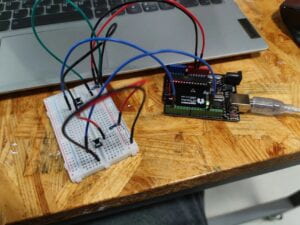In this week’s recitaton, I had to work individually to build a controller of media using Arduino and Processing.
I first chose a video by Cheng CJ on https://www.pexels.com/, because it has the perfect length for my demonstration. I wanted to use two buttons to control the video. One for pause, the other for fast forward. When one of the button was pressed, its status changes from 0 to 1. Based on this, the code in processing will decide whether to pause(go fast forward) or not.

Something went wrong when I was building the circuit and the state of button didn’t change. I consult a IMA fellow and she changed the resistor’s position.
#include "SerialRecord.h" // Change this number to send a different number of values SerialRecord writer(2); void setup() { Serial.begin(9600); pinMode(2,INPUT); pinMode(13,INPUT); } void loop() { int sensorValue1 = digitalRead(2); int sensorValue2=digitalRead(13); writer[0]=sensorValue1; writer[1] = sensorValue2; writer.send(); // This delay slows down the loop, so that it runs less frequently. This can // make it easier to debug the sketch, because new values are printed at a // slower rate. delay(10); }
In Arduino, I only use digitalRead to record the status of button and then send it to Processing.
import processing.video.*; import processing.serial.*; import osteele.processing.SerialRecord.*; Serial serialPort; SerialRecord serialRecord; Movie myMovie; int pvalue1; int state1=1; void setup() { size(600,600); myMovie = new Movie(this, "city.mp4"); myMovie.loop(); String serialPortName = SerialUtils.findArduinoPort(); serialPort = new Serial(this, serialPortName, 9600); serialRecord = new SerialRecord(this, serialPort,2); } void draw() { serialRecord.read(); int value1 = serialRecord.values[0]; int value2 = serialRecord.values[1]; println(value1,value2,state1); if (myMovie.available()) { myMovie.read(); } if (value1 != pvalue1){ if (value1==1 && state1%2==1){ myMovie.pause(); state1=state1+1; } else if (value1==1 && state1%2==0){ myMovie.play(); state1=state1+1; } } pvalue1=value1; if (value2==1){ myMovie.speed(2.0); } else{ myMovie.speed(1.0); } image(myMovie, 0, 0,width, height); }
As for the Processing part, the main problem is that every time I press the button, the variable state1 will add up for multiple times, so I cannot pause the video when pressed only once and continue when pressed again. So professor suggested I define a new variable for keeping the previous state and change the if condition outside, so that it only increase when it is different from the previous state.
The trick I mentioned above is certainly useful, but I nearly forgot it until professor reminded me. There are many more tricks to make coding easier, and all of those come from making mistakes again and again.